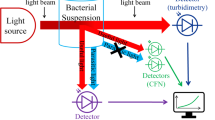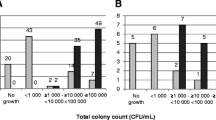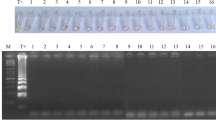Abstract
Purpose
Isothermal microcalorimetry (IMC) has recently been reported as a new method to rapidly detect urinary tract pathogens (UTP). However, further application of microcalorimetry in the clinical setting requires a standardized procedure. An important step toward such standardization is to use a reproducible growth medium. In this study, we investigated the potential of artificial urine in combination with microcalorimetry for detection of common UTP.
Methods
A microcalorimeter equipped with 48 channels was used. Detection was accomplished, and growth was monitored for four bacterial strains in artificial urine at 37 °C by measuring metabolic heat flow (μW = μJ/s) as a function of time. The strains were Escherichia coli, Proteus mirabilis, Enterococcus faecalis, and Staphylococcus aureus.
Result
Bacterial growth was detected after 3–32 h with decreasing inoculums down to 1 CFU. The gram-negative strains grew and were detected faster than their gram-positive counterparts. The growth rates the different strains were 0.75 ± 0.11 for E. coli, 0.74 ± 0.10 for E. faecalis, 1.31 ± 0.04 for P. mirabilis, and 0.56 ± 0.20 for S. aureus. The shape of individual heat flow curves was characteristic for each species independent of its initial concentration.
Conclusions
IMC allows rapid detection of UTP in artificial urine. Clearly, different heat flow patterns enable accurate pathogen differentiation. UTP detection after only 4 h is realistic. The rapid detection of UTP tested in standardized artificial urine proves the diagnostic potential of IMC and warrants further microcalorimetric studies in the clinical setting of urinary tract infections.

Similar content being viewed by others
References
Keating KN, Perfetto EM, Subedi P (2005) Economic burden of uncomplicated urinary tract infections: direct, indirect and intangible costs. Expert Rev Pharmacoecon Outcomes Res 5:457–466
Wilson ML, Gaido L (2004) Laboratory diagnosis of urinary tract infections in adult patients. Clin Infect Dis 38:1150–1158
Raynor MC, Carson CC III (2011) Urinary infections in men. Med Clin N Am 95:43–54
Hooton TM (2012) Clinical practice. Uncomplicated urinary tract infection. N Engl J Med 366:1028–1037
Brilha S, Proenca H, Cristino JM, Hanscheid T (2010) Use of flow cytometry (Sysmex) UF-100) to screen for positive urine cultures: in search for the ideal cut-off. Clin Chem Lab Med 48:289–292
Okada H, Sakai Y, Miyazaki S, Arakawa S, Hamaguchi Y, Kamidono S (2000) Detection of significant bacteriuria by automated urinalysis using flow cytometry. J Clin Microbiol 38:2870–2872
Bonkat G, Braissant O, Widmer AF, Frei R, Rieken M, Wyler S, Gasser TC, Wirz D, Daniels AU, Bachmann A (2012) Rapid detection of urinary tract pathogens using microcalorimetry: principle, technique and first results. BJU Int. doi:10.1111/j.1464-410X.2011.10902.x.
Hesse A, Classen A, Knoll M, Timmermann F, Vahlensieck W (1986) Dependence of urine composition on the age and sex of healthy subjects. Clin Chim Acta 160:79–86
Taylor EN, Curhan GC (2007) Differences in 24-hour urine composition between black and white women. J Am Soc Nephrol 18:654–659
Eisner BH, Eisenberg ML, Stoller ML (2010) Relationship between body mass index and quantitative 24-hour urine chemistries in patients with nephrolithiasis. Urology 75:1289–1293
Brooks T, Keevil CW (1997) A simple artificial urine for the growth of urinary pathogens. Lett Appl Microbiol 24:203–206
Young DS, Jackson AJ (1970) Thin-layer chromatography of urinary carbohydrates. A comparative evaluation of procedures. Clin Chem 16:954–959
Bermudez J, Lopez D, Sanahuja A, Vinas M, Loren JG (1988) Discriminant analysis of microcalorimetric data of bacterial growth. Can J Microbiol 34:1058–1062
Lopez D, Vinas M, Loren JG, Bermudez J (1987) Analysis of microcalorimetric curves for bacterial identification. Can J Microbiol 33:6–11
Pieretti B, Brunati P, Pini B, Colzani C, Congedo P, Rocchi M, Terramocci R (2010) Bacteriuria and leukocyturia: the role of automated flow cytometry compared with urine culture. J Clin Microbiol 48(11):3990–3996
St John A, Boyd JC, Lowes AJ, Price CP (2006) The use of urinary dipstick tests to exclude urinary tract infection: a systematic review of the literature. Am J Clin Pathol 126:428–436
Williams GJ, Macaskill P, Chan SF, Turner RM, Hodson E, Craig JC (2010) Absolute and relative accuracy of rapid urine tests for urinary tract infection in children: a meta-analysis. Lancet Infect Dis 10:240–250
Stamm WE, Counts GW, Running KR, Fihn S, Turck M, Holmes KK (1982) Diagnosis of coliform infection in acutely dysuric women. N Engl J Med 307:463–468
Gordon DM, Riley MA (1992) A theoretical and experimental analysis of bacterial growth in the bladder. Mol Microbiol 6:555–562
Ali AS, Townes CL, Hall J, Pickard RS (2009) Maintaining a sterile urinary tract: the role of antimicrobial peptides. J Urol 182:21–28
Boling EA, Blanchard GC, Russell WJ (1973) Bacterial identification by microcalorimetry. Nature 241:472–473
Bunker JC, James AM (1986) Microcalorimetric studies on the effects of media and environmental conditions on the growth of bacteria. Microbios 47:177–188
Christianini N, Shawe-Taylor J (2000) Introduction to support vector machines and other kernel-based learning methods. Cambridge University Press, Cambridge, pp 93–122
von Ah U, Wirz D, Daniels AU (2008) Rapid differentiation of methicillin-susceptible Staphylococcus aureus from methicillin-resistant S. aureus and MIC determinations by isothermal microcalorimetry. J Clin Microbiol 46:2083–2087
Vebo HC, Solheim M, Snipen L, Nes IF, Brede DA (2010) Comparative genomic analysis of pathogenic and probiotic Enterococcus faecalis isolates, and their transcriptional responses to growth in human urine. PLoS One 5:e12489
Sosa V, Schlapp G, Zunino P (2006) Proteus mirabilis isolates of different origins do not show correlation with virulence attributes and can colonize the urinary tract of mice. Microbiol 152:2149–2157
Conflict of interest
None of the contributing authors have any conflict of interest relevant to the subject matter or materials discussed in the manuscript. No funding or other financial support was received.
Author information
Authors and Affiliations
Corresponding author
Rights and permissions
About this article
Cite this article
Bonkat, G., Braissant, O., Rieken, M. et al. Standardization of isothermal microcalorimetry in urinary tract infection detection by using artificial urine. World J Urol 31, 553–557 (2013). https://doi.org/10.1007/s00345-012-0913-2
Received:
Accepted:
Published:
Issue Date:
DOI: https://doi.org/10.1007/s00345-012-0913-2




